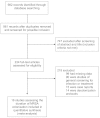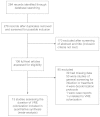Natural history of colonization with methicillin-resistant Staphylococcus aureus (MRSA) and vancomycin-resistant Enterococcus (VRE): a systematic review
- PMID: 24678646
- PMCID: PMC4230428
- DOI: 10.1186/1471-2334-14-177
Natural history of colonization with methicillin-resistant Staphylococcus aureus (MRSA) and vancomycin-resistant Enterococcus (VRE): a systematic review
Abstract
Background: No published systematic reviews have assessed the natural history of colonization with methicillin-resistant Staphylococcus aureus (MRSA) or vancomycin-resistant Enterococcus (VRE). Time to clearance of colonization has important implications for patient care and infection control policy.
Methods: We performed parallel searches in OVID Medline for studies that reported the time to documented clearance of MRSA and VRE colonization in the absence of treatment, published between January 1990 and July 2012.
Results: For MRSA, we screened 982 articles, identified 16 eligible studies (13 observational studies and 3 randomized controlled trials), for a total of 1,804 non-duplicated subjects. For VRE, we screened 284 articles, identified 13 eligible studies (12 observational studies and 1 randomized controlled trial), for a total of 1,936 non-duplicated subjects. Studies reported varying definitions of clearance of colonization; no study reported time of initial colonization. Studies varied in the frequency of sampling, assays used for sampling, and follow-up period. The median duration of total follow-up was 38 weeks for MRSA and 25 weeks for VRE. Based on pooled analyses, the model-estimated median time to clearance was 88 weeks after documented colonization for MRSA-colonized patients and 26 weeks for VRE-colonized patients. In a secondary analysis, clearance rates for MRSA and VRE were compared by restricting the duration of follow-up for the MRSA studies to the maximum observed time point for VRE studies (43 weeks). With this restriction, the model-fitted median time to documented clearance for MRSA would occur at 41 weeks after documented colonization, demonstrating the sensitivity of the pooled estimate to length of study follow-up.
Conclusions: Few available studies report the natural history of MRSA and VRE colonization. Lack of a consistent definition of clearance, uncertainty regarding the time of initial colonization, variation in frequency of sampling for persistent colonization, assays employed and variation in duration of follow-up are limitations of the existing published literature. The heterogeneity of study characteristics limits interpretation of pooled estimates of time to clearance, however, studies included in this review suggest an increase in documented clearance over time, a result which is sensitive to duration of follow-up.
Figures





Similar articles
-
Determining the clinical significance of co-colonization of vancomycin-resistant enterococci and methicillin-resistant Staphylococcus aureus in the intestinal tracts of patients in intensive care units: a case-control study.Ann Clin Microbiol Antimicrob. 2019 Oct 10;18(1):28. doi: 10.1186/s12941-019-0327-8. Ann Clin Microbiol Antimicrob. 2019. PMID: 31601221 Free PMC article.
-
Systematic review of measurement and adjustment for colonization pressure in studies of methicillin-resistant Staphylococcus aureus, vancomycin-resistant enterococci, and clostridium difficile acquisition.Infect Control Hosp Epidemiol. 2011 May;32(5):481-9. doi: 10.1086/659403. Infect Control Hosp Epidemiol. 2011. PMID: 21515979 Free PMC article. Review.
-
Clinical significance of methicillin-resistant Staphylococcus aureus and vancomycin-resistant enterococci colonization in liver transplant recipients.Korean J Intern Med. 2015 Sep;30(5):694-704. doi: 10.3904/kjim.2015.30.5.694. Epub 2015 Aug 27. Korean J Intern Med. 2015. PMID: 26354064 Free PMC article.
-
Recovery of both vancomycin-resistant enterococci and methicillin-resistant Staphylococcus aureus from culture of a single clinical specimen from colonized or infected patients.Infect Control Hosp Epidemiol. 2009 Feb;30(2):130-8. doi: 10.1086/593957. Infect Control Hosp Epidemiol. 2009. PMID: 19128183
-
Methicillin-resistant Staphylococcus aureus and vancomycin-resistant Enterococci co-colonization in patients: A meta-analysis.Am J Infect Control. 2020 Aug;48(8):925-932. doi: 10.1016/j.ajic.2019.11.010. Epub 2019 Dec 19. Am J Infect Control. 2020. PMID: 31864808 Review.
Cited by
-
Infection Prevention and Control Strategies According to the Type of Multidrug-Resistant Bacteria and Candida auris in Intensive Care Units: A Pragmatic Resume including Pathogens R0 and a Cost-Effectiveness Analysis.Antibiotics (Basel). 2024 Aug 22;13(8):789. doi: 10.3390/antibiotics13080789. Antibiotics (Basel). 2024. PMID: 39200090 Free PMC article. Review.
-
Loss of Vancomycin-Resistant Enterococcus Fecal Dominance in an Organ Transplant Patient With Clostridium difficile Colitis After Fecal Microbiota Transplant.Open Forum Infect Dis. 2015 Jun 3;2(2):ofv078. doi: 10.1093/ofid/ofv078. eCollection 2015 Apr. Open Forum Infect Dis. 2015. PMID: 26180828 Free PMC article.
-
Microbial-derived products as potential new antimicrobials.Vet Res. 2018 Jul 31;49(1):66. doi: 10.1186/s13567-018-0563-5. Vet Res. 2018. PMID: 30060765 Free PMC article. Review.
-
A Preliminary Study on Antimicrobial Susceptibility of Staphylococcus spp. and Enterococcus spp. Grown on Mannitol Salt Agar in European Wild Boar (Sus scrofa) Hunted in Campania Region-Italy.Animals (Basel). 2021 Dec 31;12(1):85. doi: 10.3390/ani12010085. Animals (Basel). 2021. PMID: 35011191 Free PMC article.
-
A novel high-resolution melting analysis approach for rapid detection of vancomycin-resistant enterococci.Ann Saudi Med. 2018 May-Jun;38(3):200-207. doi: 10.5144/0256-4947.2018.200. Ann Saudi Med. 2018. PMID: 29848938 Free PMC article.
References
-
- Shenoy ES, Walensky RP, Lee H, Orcutt B, Hooper DC. Resource burden associated with contact precautions for methicillin-resistant Staphylococcus aureus and vancomycin-resistant Enterococcus: the patient access Managers’ perspective. Infect Control Hosp Epidemiol. 2012;33(8):849–852. doi: 10.1086/666629. - DOI - PMC - PubMed
Publication types
MeSH terms
Grants and funding
LinkOut - more resources
Full Text Sources
Other Literature Sources
Medical

